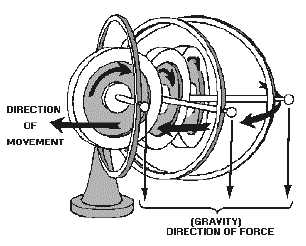3-4
Figure 3-4.—Gyro precession.
Gyro action may be summarized as follows: A spinning gyro tends to keep its axis pointing in the
same direction. This is called RIGIDITY. If you apply a force that tends to change the direction of the
spin axis, the axis will move at a right angle to the direction of the applied force. The direction of
precession will be 90º clockwise from the applied force if the rotor is spinning clockwise (when viewed
from the "free" end of the rotor's axis); if the rotor is spinning counterclockwise, the precession will be
90º counterclockwise. If the axis is horizontal, and you try to tilt it, the axis will turn. If the axis is
horizontal, and you try to turn it, the axis will tilt. This second characteristic of a gyro is called
PRECESSION.
Because of precession, we can control the direction that the spin axis points. This enables us to aim
the spin axis where we want it to point. Without precession, the rigidity of the gyro would be useless.
Q-1. Can any rapidly spinning object be considered a gyroscope?
Q-2. In the drawing in figure 3-1, which axis is the gyro spin axis?
Q-3. What gyro property causes the gyro to remain in a fixed position?
Q-4. What type(s) of force does a gyro resist?
Q-5. In what direction will a gyro precess in response to an outside force?
BASIC GYRO ELEMENTS
The gyro shown in figure 3-5 is a basic, universally mounted gyro, sometimes called a free gyro. Its
components are rotor, inner gimbal, outer gimbal, and base or support. Gimbals are devices that permit
the rotor to assume any position and retain that position when the support is tipped or repositioned. Note
that in figure 3-5, the support may be moved about all axes without the rotor position being disturbed.

